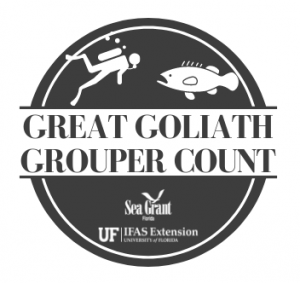
Every June, dozens of divers across the state embark on a search for one of Florida’s most quintessential and charismatic reef fish. Since 2010, these citizen scientists have been providing data regarding Goliath grouper presence and size distribution at sites across Florida. This year marked the 12th annual Great Goliath Grouper Count.
Diving for Data
 In 1990 the harvest of Goliath grouper (Epinephelus itajara – also formerly known as jewfish), was prohibited in all U.S. waters following decades of overfishing. The population in Florida has responded well to protective measures and numbers have been rebuilding since the moratorium. However, stock assessment remains complicated and the full extent of recovery throughout their geographic range remains unclear [1].
In 1990 the harvest of Goliath grouper (Epinephelus itajara – also formerly known as jewfish), was prohibited in all U.S. waters following decades of overfishing. The population in Florida has responded well to protective measures and numbers have been rebuilding since the moratorium. However, stock assessment remains complicated and the full extent of recovery throughout their geographic range remains unclear [1].
Since 2010, UF/IFAS Extension, Florida Sea Grant and the Florida Fish and Wildlife Conservation Commission Fish and Wildlife Research Institute have coordinated an annual citizen science event to collect data on the distribution and abundance of Goliath grouper in Florida. During this “Great Goliath Grouper Count,” trained divers perform underwater surveys at designated reefs throughout Florida. What began as a regional effort in southwest Florida has expanded over the past twelve years to include sites off the Panhandle, Florida Keys and Atlantic coast of Florida (Fig. 1). Divers donate their time to complete standardized data reports, which are compiled by Florida Sea Grant before being submitted to management at FWC.

By design, the GGGC survey targets nearshore and offshore reef habitats – specifically artificial reefs – where adult Goliath grouper are known to aggregate. The event occurs during June, when water clarity is normally good and underwater temperatures encourage diver participation. June is also well before fish begin moving around for the spawning season (August – September). So, fish are expected to be relatively sedentary at their resident sites, making the likelihood of double counting the same individuals at multiple sites is relatively slim.

The 2021 GGGC covered a lot of ground, with surveys submitted from all over the state. Fifty-eight volunteers surveyed 89 sites and counted a total of 255 Goliath grouper. This was good news, since the 2020 survey was understandably thwarted by the pandemic. Years when there are a higher number of surveys typically result in larger total numbers of fish reported (Fig. 2). The greatest numbers of Goliath grouper are observed at high relief artificial reefs in southwest Florida, which has historically been the center of abundance for this species.
Notably, southwest Florida is also where the most extensive nursery habitat for juvenile Goliath grouper remains. Like many reef fishes, juvenile Goliath groupers spend their first few years in estuaries (until they are about 3 feet long), and they are dependent upon healthy mangrove habitats. The relatively undeveloped shoreline of the Ten Thousand Islands and Everglades National Park serve as important juvenile habitat that are critical to the Goliath grouper population in Florida. These healthy nursery habitats are one of the factors that contribute to southwest Florida being an area of abundance for Goliath grouper.
Goliath grouper preference for high relief structure is one of the reasons these fish are likely to be encountered by divers and anglers (who also like to visit these types of reefs). Increasing interactions between people and Goliath grouper have initiated a push by some sectors to reopen a fishery, and the state of Florida is currently considering options for some sort of limited harvest. Because traditional fisheries stock assessments are not currently feasible for Goliath grouper, FWC uses a suite of non-traditional methods to track the status of the population in Florida waters.

The Great Goliath Grouper Count was developed to involve stakeholders in the collection of fundamental fisheries data, and to provide these data to management with the hope that they can be informative through time. To date, over 150 volunteers have spent more than 350 hours underwater and completed 768 surveys. On average, about 200 individual fish are recorded each year. Extension efforts promote collaboration with citizen scientists and allow for coordinated data collection over a broad geographic area within a relatively short period, aimed to assist policy makers in future management efforts related to this species.
References
[1] For more information on the population status and biology of Goliath grouper, check out these links:
- FWC: compiled list of reports and publications
- FSU Marine Ecology and Conservation: Goliath Grouper
- UF Florida Museum Discover Fishes: Goliath Grouper
- Florida Sea Grant Bite-Sized Science webinar: Goliath Grouper Facts and Fiction
 2
2
